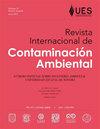A城市河流水生态系统健康评价及影响因素分析——以北云河为例
IF 0.4
4区 环境科学与生态学
Q4 ENVIRONMENTAL SCIENCES
引用次数: 0
摘要
北云河是中国北方典型的城市河流,其生态系统健康状况因城市化而恶化。为了评估这种健康状况,在整个流域进行了一项调查。选取13个指标构建生态系统健康评价体系,采用综合指数法对北云河生态系统健康进行量化。采用冗余分析(RDA)方法检测影响生态系统健康的关键因子。结果表明,河流的健康状况大多为中等,在38个调查点中,健康状况为良好的占10%,一般的占47%,较差的占40%,极差的占3%。中上游健康状况好于下游,干流健康状况好于支流。各支流中,灞河(上、中游)健康状况最好,沣河(下游)最差。RDA结果表明,河流硬化率、闸坝数量和流域人口密度是影响北云河生态系统健康的关键因素。本研究可为城市河流生态系统健康评价提供参考。本文章由计算机程序翻译,如有差异,请以英文原文为准。
Water ecosystem health evaluation and influencing factors analysis of AN urban river: A case study at Beiyunhe River, Northern China
The Beiyunhe River is a typical urban river in northern China, and the health status of its ecosystem is degraded by urbanization. To evaluate this health status, a survey was performed throughout the basin. Thirteen indexes were selected to construct an ecosystem health evaluation system, and a composite index method was used to quantify the Beiyunhe River’s ecosystem health. Redundancy analysis (RDA) was used to detect the key factors influencing ecosystem health. The results showed that the river’s health status was mostly moderate: of the 38 surveyed points, the health status of 10% was Good, 47% was Average, 40% was Poor, and 3% was Very Poor. The upper and middle reaches were in better health than the lower reaches, and the main stream health was better than the tributaries. Among the tributaries, Bahe River (upper and middle reaches) had the best health status, whereas Fenghe River (lower reaches) had the worst. RDA showed that the ratio of hardening of the river, number of water-blocking structures (gates and dams), and population density in the catchment area were the key factors affecting the health of the Beiyunhe River ecosystem. This study can be used as a reference for the evaluation of the health of urban river ecosystems.
求助全文
通过发布文献求助,成功后即可免费获取论文全文。
去求助
来源期刊

Revista Internacional De Contaminacion Ambiental
ENVIRONMENTAL SCIENCES-
CiteScore
0.90
自引率
16.70%
发文量
59
期刊介绍:
En esta revista se aceptan para su publicación trabajos originales y de revisión sobre aspectos físicos y químicos de la contaminación, investigaciones sobre la distribución y los efectos biológicos y ecológicos de los contaminantes; así como sobre tecnología e implementación de nuevas técnicas para su medida y control; también son aceptados estudios sociológicos, económicos y legales acerca del tema. Se publicarán los escritos que mediante arbitraje de especialistas y a juicio del Consejo Editorial tengan el nivel y la calidad adecuados para ello y su contenido será responsabilidad única de los autores. La Revista Internacional de Contaminación Ambiental es de periodicidad trimestral y se publica los días 1 de febrero, mayo, agosto y noviembre.
 求助内容:
求助内容: 应助结果提醒方式:
应助结果提醒方式:


